Csf 1 receptor structure Study guides, Class notes & Summaries
Looking for the best study guides, study notes and summaries about Csf 1 receptor structure? On this page you'll find 233 study documents about Csf 1 receptor structure.
Page 2 out of 233 results
Sort by
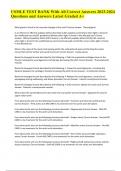
-
USMLE TEST BANK | Questions and Answers Latest Update Graded A+
- Exam (elaborations) • 236 pages • 2023
- Available in package deal
-
- $19.49
- + learn more
USMLE TEST BANK | Questions and Answers Latest Update Graded A+. What is the name of the spinal cord passing within the subarachnoid space and forming the spinal nerves that exit the lumbar and sacral foramina? Correct Answer: Cauda equina Name the laryngeal muscle described by the following: • Pulls the arytenoids cartilages closer to the thyroid, relaxing the vocal ligaments and thereby decreasing the pitch Correct Answer: Thyroarytenoid muscles Name the laryngeal muscle described by th...

-
USMLE TEST BANK With All Correct Answers 2023-2024 | Questions and Answers Latest Graded A+
- Exam (elaborations) • 236 pages • 2023
- Available in package deal
-
- $18.49
- + learn more
USMLE TEST BANK With All Correct Answers 2023-2024 | Questions and Answers Latest Graded A+. What gland is found in the muscular triangle of the neck? Correct Answer: Thyroid gland Is an afferent or efferent pupillary defect described as B/L pupillary constriction when light is shined in the unaffected eye and B/L paradoxical dilation when light is shined in the affected eye? Correct Answer: Afferent pupillary defect (CN II lesion); in an efferent pupillary defect (CN III), B/L constrict whe...
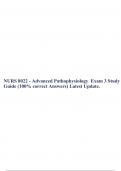
-
NURS 8022 - Advanced Pathophysiology Exam 3 Study Guide (100% correct Answers) Latest Update.
- Exam (elaborations) • 90 pages • 2023
- Available in package deal
-
- $14.99
- + learn more
NURS 8022 - Advanced Pathophysiology Exam 3 Study Guide (100% correct Answers) Latest Update. Respiratory Structures of pulmonary system – NOT ON STUDY GUIDE • Lobes (3 on right, 2 on left) - segments – lobules • Blood vessels serve the pulmonary system • Chest wall/thoracic cage • Diaphragm: involved in ventilation – dome shaped muscle that separates the thoracic and abdominal cavities • Mediastinum: space between lungs containing heart, great vessels, and esophagus •...
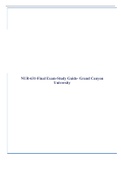
-
NUR-631-Final Exam-Study Guide- Grand Canyon University
- Exam (elaborations) • 15 pages • 2023
-
- $8.99
- 1x sold
- + learn more
Final Exam – Study Guide Definitions/Descriptions Describe the type of lesions found in psoriasis & seborrheic and actinic keratosis. Elevated, firm, and rough lesion with flat top surface great er than 1 cm in diameter Describe the skin lesions found in Varicella (chickenpox) and herpes zoster (shingles). Elevated circumscribed, superficial lesion filled with serous fluid, less than 1 cm in diameter Describe the pathogenetic mechanism of polycystic ovarian syndrome (POS). POS has at least two...
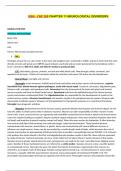
-
MSN - FNP 590 CHAPTER 11 NEUROLOGICAL DISORDERS.
- Exam (elaborations) • 31 pages • 2024
-
- $15.99
- + learn more
MSN - FNP 590 CHAPTER 11 NEUROLOGICAL DISORDERS. NEURAL FUNCTION Anatomy and physiology: Brain: CNS Spinal cord: CNS Nerves: PNS (cranial and spinal nerves) 1. CNS – Meninges encase the cns, dura mater is the outer and toughest layer, arachnoid is middle, and pia is innermost that rests directly on brain and spinal cord. CSF fills space between arachnoid and pia mater (produced by choroid plexus cells in brain’s ventricles). 600 ml in adults and 50ml in newborns produced da...
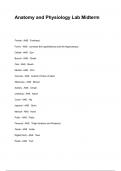
-
Anatomy and Physiology Lab Midterm
- Exam (elaborations) • 31 pages • 2024
-
- $12.49
- + learn more
Anatomy and Physiology Lab Midterm Frontal - ANS Forehead Fornix - ANS connects the hypothalamus and the hippocampus. Orbital - ANS Eye Buccal - ANS Cheek Oral - ANS Mouth Mental - ANS Chin Cervical - ANS Anterior Portion of Neck Mammary - ANS Breast Axillary - ANS Armpit Umbilical - ANS Navel Coxal - ANS Hip Inguinal - ANS Groin Manual - ANS Hand Pubic - ANS Pubis Femoral - ANS Thigh (Anterior and Posterior) ...
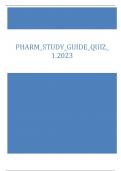
-
PHARM_STUDY_GUIDE_QUIZ_ 1.2023
- Exam (elaborations) • 37 pages • 2023
-
- $17.99
- + learn more
PHARM_STUDY_GUIDE_QUIZ_ 1.2023 1. What are the BON rules and regulations for prescriptive authority for the advance practice nurse? 1. Texas is very restricted 2. Describe the pharmacokinetic processes of absorption, distribution, metabolism and elimination and how differences in these areas affect drug action. 1. Absorption 1. Drug’s movement from the site of administration into the blood. 2. Distribution 1.Drug’s movement from the blood into the interstitial space oftissues and ...
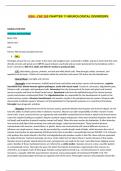
-
MSN - FNP 590 CHAPTER 11 NEUROLOGICAL DISORDERS.
- Exam (elaborations) • 31 pages • 2024
-
- $15.89
- + learn more
MSN - FNP 590 CHAPTER 11 NEUROLOGICAL DISORDERS. NEURAL FUNCTION Anatomy and physiology: Brain: CNS Spinal cord: CNS Nerves: PNS (cranial and spinal nerves) 1. CNS – Meninges encase the cns, dura mater is the outer and toughest layer, arachnoid is middle, and pia is innermost that rests directly on brain and spinal cord. CSF fills space between arachnoid and pia mater (produced by choroid plexus cells in brain’s ventricles). 600 ml in adults and 50ml in newborns produced da...
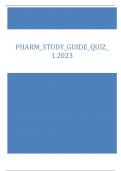
-
PHARM_STUDY_GUIDE_QUIZ_ 1.2023
- Exam (elaborations) • 37 pages • 2023
-
- $17.74
- + learn more
PHARM_STUDY_GUIDE_QUIZ_ 1.2023 1. What are the BON rules and regulations for prescriptive authority for the advance practice nurse? 1. Texas is very restricted 2. Describe the pharmacokinetic processes of absorption, distribution, metabolism and elimination and how differences in these areas affect drug action. 1. Absorption 1. Drug’s movement from the site of administration into the blood. 2. Distribution 1.Drug’s movement from the blood into the interstitial space oftissues and ...
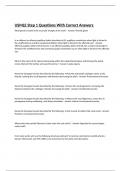
-
USMLE Step 1 Questions With Correct Answers
- Exam (elaborations) • 184 pages • 2023
- Available in package deal
-
- $17.99
- + learn more
What gland is found in the muscular triangle of the neck? - Answer Thyroid gland Is an afferent or efferent pupillary defect described as B/L pupillary constriction when light is shined in the unaffected eye and B/L paradoxical dilation when light is shined in the affected eye? - Answer Afferent pupillary defect (CN II lesion); in an efferent pupillary defect (CN III), B/L constrict when light is shined in the unaffected eye and consentual pupil constriction occurs when light is shined in the...

$6.50 for your textbook summary multiplied by 100 fellow students... Do the math: that's a lot of money! Don't be a thief of your own wallet and start uploading yours now. Discover all about earning on Stuvia


